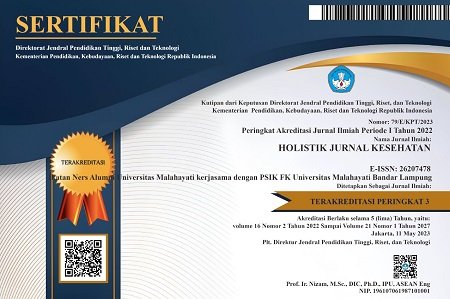Remaja yang terinfeksi HIV/AIDS di Indonesia (Analisis Data Publikasi SDKI 2017)
Abstract
Background: Acquired Immune Deficiency Syndrome (AIDS) is a collection of symptoms due to a decrease in the immune system. HIV/AIDS can lower a person's immune system and make a person susceptible to serious infections. Globally, HIV/AIDS is still a public health problem. Based on the data, there are many people living with HIV whose status is still infected with HIV but have not yet entered the AIDS stage. A person's infected status can only be known through laboratory tests and can be transmitted to other people. HIV/AID does not only affect adults but can also affect infants, children and adolescents. New HIV infection among adolescents (15 – 19 years) is a problem in all regions
Purpose: To identify adolescents infected with HIV/AIDS in Indonesia based on the 2017 IDHS Publication Data Analysis related to demographic factors
Method: Quantitative research using the Cross-Sectional method using secondary data from 2017 Indonesian Demographic and Health Survey (IDHS), conducted in December 2019-May 2020 with a sample of all adolescents aged 15-19 years, with a single status of 445. Analysis using the Chi-Square test using SPSS version 21.
Results: The results showed that there was a significant relationship between the area of residence (p-value 0.00) and economic status (p-value 0.00) on know how become infected of HIV/AIDS.
Conclusion: There is a relationship between the area of residence and economic status on knowledge. So that there is a need for a strategy approach and modification of the media for disseminating information on HIV/AIDS to Indonesian adolescents as an effort to reduce the incidence of HIV/AIDS in Indonesia.
Keywords: Infected; HIV/AIDS; Adolescents
Pendahuluan : Acquired Immune Deficiency Syndrome (AIDS) merupakan kumpulan gejala akibat penurunan sistem imun . HIV/AIDS dapat menurunkan daya tahan tubuh seseorang dan membuat seseorang mudah terinfeksi yang serius. Secara global HIV/AIDS masih menjadi permasalahan kesehatan masyarakat. Berdasarkan data terdapat banyak odha yang statusnya masih terinfeksi HIV namun belum masuk pada stadium AIDS. Seseorang berstatus terinfeksi hanya bisa diketahui melalui pemeriksaan laboratorium dan dapat menularkan kepada orang lain. HIV/AID tidak hanya mengenai orang dewasa tetapi dapat juga pada bayi, anak-anak maupun remaja. Infeksi HIV baru di kalangan remaja ( 15 – 19 tahun) merupakan masalah di semua wilayah
Tujuan : Untuk mengidentifikasi remaja yang terinfeksi HIV/AIDS di Indonesia berdasarkan Analisis Data Publikasi SDKI 2017 yang berhubungan dengan faktor demografi
Metode : Penelitian kuantitatif dengan metode Cross Sectional menggunakan data sekunder survey Demografi dan Kesehatan Indonesia (SDKI) 2017, dilakuakan pada bulan Desember 2019-Mei 2020 dengan Sampel seluruh remaja usia 15–19 tahun, status lajang sebanyak 445. Analisa mengunakan uji Chi-Square dengan menggunakan SPSS versi 21.
Hasil : Hasil penelitian menunjukkan adanya hubungan yang signifikan antara wilayah tempat tinggal ( p-value 0,00) , status ekonomi ( p-value 0,00) terhadap tahu bagaimana menjadi terinfeksi HIV/AIDS.
Simpulan : Terdapat hubungan wilayah tempat tinggal dan status ekonomi terhadap terinfeksi. Sehingga perlu adanya strategi pendekatan dan modifikasi media penyebaran informasi HIV/AIDS pada remaja Indonesia sebagai upaya menurunkan angka kejadian HIV/AIDS Remaja di Indonesia.
Keywords
References
Abate, B. B., Kassie, A. M., Reta, M. A., Ice, G. H., & Haile, Z. T. (2020). Residence and young women’s comprehensive HIV knowledge in Ethiopia. BMC Public Health, 20(1), 1-10.
Black, J. M., & Hawks, J. H. (2014). Keperawatan Medikal Bedah; Manajemen klinis untuk hasil yang diharapkan.
Chen, M., Liao, Y., Liu, J., Fang, W., Hong, N., Ye, X., & Liao, W. (2016). Comparison of sexual knowledge, attitude, and behavior between female Chinese college students from urban areas and rural areas: a hidden challenge for HIV/AIDS control in China. BioMed research international, 2016.
Chirwa, G. C. (2019). Socio-economic inequality in comprehensive knowledge about HIV in Malawi. Malawi Medical Journal, 31(2), 104-111.
Ditjen PPM dan PL Depkes RI (2017) Statistik kasus HIV POSITIF di Indonesia di Laporkan Januari s.d Desember 2017
Folayan, M. O., Adebajo, S., Adeyemi, A., & Ogungbemi, K. M. (2015). Differences in sexual practices, sexual behavior and HIV risk profile between adolescents and young persons in rural and urban Nigeria. PloS one, 10(7), e0129106.
Kefale, B., Damtie, Y., Yalew, M., Adane, B., & Arefaynie, M. (2020). Predictors of comprehensive knowledge of HIV/AIDS among people aged 15–49 years in Ethiopia: a multilevel analysis. HIV/AIDS (Auckland, NZ), 12, 449.
Kowalaj, J.p., Welsh, W., Mayer, B., (2014). Buku ajar Patofisiologi: professional guide to pathophysiology
Kenu, E., Obo-Akwa, A., Nuamah, G. B., Brefo, A., Sam, M., & Lartey, M. (2014). Knowledge and disclosure of HIV status among adolescents and young adults attending an adolescent HIV clinic in Accra, Ghana. BMC research notes, 7(1), 1-6.
Ma’ruf, M. A., & Phuengsamran, D. (2016). Association between HIV-AIDS related knowledge and HIV-AIDS related behavior among urban young adult men in Indonesia. In Asian Academic Society International Conference Proceeding Series.
Notoatmodjo, S. (2010). Ilmu perilaku kesehatan.
Oktarina, O., Hanafi, F., & Budisuari, M. A. (2009). Hubungan antara karakteristik responden, keadaan wilayah dengan pengetahuan, sikap terhadap HIV/AIDS pada masyarakat Indonesia. Buletin Penelitian Sistem Kesehatan, 12(4), 21288.
Othman, M. N., Yap, S. F., & Wee, Y. G. (2011). Examining the relationship between gender, age, education level and social cognitive factors in a health setting. International Journal of Business and Management, 6(9), 79.
UNAIDS. (2018). Global AIDS monitoring 2018, Indicators for monitoring the 2016 united nations political declaration on ending AIDS. Geneva.
UNICEF. (2020). Reimagining a resilient HIV response for children, adolescents and pregnant women living with HIV
Veinot, T. C., & Harris, R. (2011). Talking about, knowing about HIV/AIDS in Canada: A rural‐urban comparison. The Journal of Rural Health, 27(3), 310-318.
Widayati, A., Suryawati, S., de Crespigny, C., & Hiller, J. E. (2012). Knowledge and beliefs about antibiotics among people in Yogyakarta City Indonesia: a cross sectional population-based survey. Antimicrobial resistance and infection control, 1(1), 1-7.
WHO (2021). HIV/AIDS. Diakses dari: https://www.who.int/news-room/fact-sheets/detail/hiv-aids.
WHO (2010). The WHO clinical staging system for HIV/AIDS, Switzerland : World Health Organanization
DOI: https://doi.org/10.33024/hjk.v16i2.5336
Refbacks
- There are currently no refbacks.
Copyright (c) 2022 Holistik Jurnal Kesehatan

This work is licensed under a Creative Commons Attribution-NonCommercial 4.0 International License.














